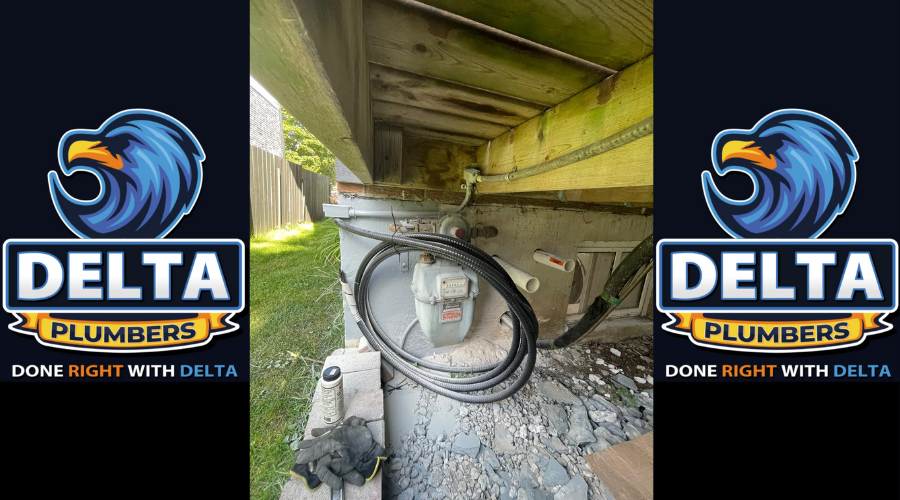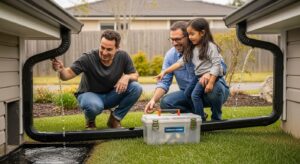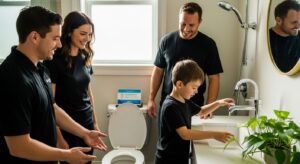Winterizing your plumbing system is essential to protect your home from the risks associated with freezing temperatures, such as burst pipes, costly repairs, and water damage. As winter approaches, homeowners should take proactive steps to ensure their plumbing systems are well-prepared for the cold months ahead. This guide provides step-by-step instructions on how to winterize your plumbing, prepare pipes for winter, and keep your system safe and efficient.

Picture Source – Delta Plumbers
How to Winterize a Plumbing System?
To winterize a plumbing system, you need to take several precautionary measures that prevent the water inside the pipes from freezing. Here’s a comprehensive guide on how to effectively winterize your plumbing system:
1. Turn Off the Water Supply:
Start by turning off the main water supply to prevent any water from flowing into the pipes. This step is crucial if you plan to leave your home for an extended period during the winter months.
2. Drain the Water Lines:
After turning off the water supply, open all faucets, both indoor and outdoor, to drain the water remaining in the pipes. Make sure to flush all toilets to clear the water from the tank and bowl.
3. Insulate Exposed Pipes:
Pipes located in unheated areas, such as basements, attics, garages, and crawl spaces, are most vulnerable to freezing. Use pipe insulation or heat tape to wrap these exposed pipes and keep them warm throughout the winter.
4. Seal Gaps and Cracks:
Inspect your home for any gaps or cracks around windows, doors, and walls where cold air might seep in and cause pipes to freeze. Use caulk or weatherstripping to seal these openings.
5. Disconnect Outdoor Hoses:
Disconnect and store any outdoor hoses. Ensure that the water supply to the outdoor faucets is turned off and drain any remaining water. Use faucet covers to provide additional protection against freezing temperatures.
6. Consider Installing Frost-Free Spigots:
Replace regular spigots with frost-free ones. These are designed to prevent freezing by shutting off water flow further back inside the wall where it is warmer.
7. Maintain a Consistent Indoor Temperature:
Keep your thermostat set to at least 55°F (13°C) even when you are away from home. A consistent indoor temperature prevents the interior pipes from freezing.
8. Monitor and Maintain Water Heater:
Ensure your water heater is in good working condition. Insulate it with a water heater blanket, especially if it is located in an unheated area, to prevent heat loss and maintain efficient operation.
By following these steps, you can protect your plumbing system from freezing temperatures and avoid costly damages during winter.
Also Read: Green Plumbing Solutions: Eco-Friendly Tips for Your Home

Picture Source – Delta Plumbers
How Do You Prepare Your Plumbing for Winter?
Preparing your plumbing for winter involves taking preventative measures to safeguard your pipes against freezing. Here are some key steps to help you prepare:
1. Conduct a Plumbing Inspection:
Before winter sets in, conduct a thorough inspection of your plumbing system. Check for leaks, drips, or any signs of wear and tear in your pipes, fixtures, and water heater. Repair any issues immediately to prevent them from worsening during cold weather.
2. Install Pipe Insulation:
As mentioned earlier, insulating pipes in unheated areas is crucial to preventing freezing. Use foam pipe insulation or heat tape, which are specifically designed to protect pipes from cold temperatures.
3. Keep Cabinet Doors Open:
Open cabinet doors under sinks, especially those located along exterior walls, to allow warm air to circulate around the pipes. This simple step can significantly reduce the risk of pipes freezing.
4. Use Space Heaters for Extra Protection:
If you have pipes in particularly cold areas, like basements or attics, consider using space heaters to keep the temperature above freezing. However, make sure to follow all safety guidelines to prevent fire hazards.
5. Install Leak Detectors:
Leak detectors can alert you to potential issues before they become major problems. Install these devices in key areas, such as near water heaters, washing machines, and under sinks, to quickly detect leaks or frozen pipes.
6. Inspect Exterior Plumbing:
Check all exterior faucets, hoses, and sprinkler systems for leaks or damage. Ensure they are properly drained and insulated. Consider shutting off the water supply to these areas if they are not needed during the winter.
By taking these steps, you can prepare your plumbing system to withstand freezing temperatures and reduce the risk of winter-related plumbing issues.
Also Read: Emergency Plumbing Tips: What to Do When You Have a Leak

Picture Source – Delta Plumbers
How Do You Clear Pipes Before Winter?
Clearing your pipes before winter is an essential step to prevent them from freezing. Here’s how you can do it effectively:
1. Turn Off the Main Water Supply:
Start by shutting off the main water supply to your home. This will prevent any more water from entering the pipes.
2. Open All Faucets and Drains:
Open all faucets, both indoor and outdoor, to drain the remaining water from the pipes. Begin with the highest faucet in your home and work your way down to the lowest.
3. Flush All Toilets:
Flush all toilets to remove water from the tanks and bowls. It is important to get as much water out of the plumbing system as possible.
4. Use an Air Compressor:
For a more thorough clearance, consider using an air compressor to blow out any remaining water in the pipes. This method is particularly effective for homes in regions with extremely cold winters.
5. Drain the Water Heater:
If you plan to leave your home for an extended period during winter, it’s advisable to drain your water heater. Follow the manufacturer’s instructions or consult a professional plumber to do this safely.
6. Check for Residual Water:
After draining, check all taps and drains for any remaining water. Make sure that every pipe is completely clear.
Clearing your pipes before winter can help prevent freezing and burst pipes, saving you from costly repairs and water damage.
Also Read: Right Plumber for Your Needs: How to Choose Best

Picture Source – Delta Plumbers
Will Antifreeze Keep Pipes from Freezing?
Yes, antifreeze can help keep pipes from freezing, but it must be used correctly and safely. Here’s how you can use antifreeze to protect your plumbing:
1. Use the Right Type of Antifreeze:
Use only non-toxic antifreeze designed for plumbing systems, such as RV antifreeze. Do not use automotive antifreeze, as it contains toxic chemicals that are harmful to humans, pets, and the environment.
2. Pour Antifreeze into Drains and Toilets:
After draining the water from your plumbing system, pour a small amount of non-toxic antifreeze into sinks, bathtubs, and toilet bowls. This will prevent any remaining water from freezing and causing damage.
3. Follow Manufacturer’s Instructions:
Always follow the manufacturer’s instructions on how much antifreeze to use. Overuse can lead to problems, while underuse may not provide adequate protection.
4. Hire a Professional:
If you are unsure about using antifreeze, consider hiring a professional plumber to do it for you. They have the expertise to ensure it is done correctly and safely.
While antifreeze can help keep pipes from freezing, it should be used as a last resort and only in situations where pipes cannot be adequately drained.
Also Read: How to Unclog Drains Naturally

Picture Source – Delta Plumbers
Should I Drain My Pipes to Keep Them from Freezing?
Yes, draining your pipes is one of the most effective ways to prevent them from freezing. When there is no water in the pipes, there is nothing to freeze. Here’s why draining is beneficial:
1. Prevents Pipe Bursts:
Water expands when it freezes, which can cause pipes to burst. Draining pipes removes the water, eliminating this risk.
2. Reduces Repair Costs:
Preventing pipe bursts through draining can save you from costly repairs and water damage restoration.
3. Ideal for Vacant Homes:
If you plan to leave your home for an extended period during winter, draining the pipes is essential to prevent freezing and bursting.
To drain your pipes, turn off the main water supply, open all faucets and valves, and flush toilets to remove as much water as possible. Consider using an air compressor for a more thorough drain.
Also Read: Signs You Need to Replace Your Plumbing Pipes

Picture Source – Delta Plumbers
How Do You Close Pipes for Winter?
Closing pipes for winter involves a few key steps to ensure they are properly protected from freezing temperatures:
1. Shut Off Water Supply:
Turn off the main water supply to your home. If you have outdoor water lines or sprinkler systems, shut off their water supply as well.
2. Open All Faucets and Drain Pipes:
Open all faucets to allow any remaining water to flow out. This will help prevent pressure build-up that could lead to bursting.
3. Insulate Pipes:
Wrap any exposed pipes with insulation or heat tape. This step is particularly important for pipes located in unheated areas like basements or crawl spaces.
4. Add Antifreeze if Necessary:
In some cases, you may want to add non-toxic antifreeze to drains and toilets to prevent any residual water from freezing.
5. Seal Off Entry Points:
Seal any gaps, cracks, or openings around windows, doors, and walls to prevent cold air from entering and freezing your pipes.
By following these steps, you can effectively close your pipes for winter and protect them from freezing.
Also Read: Regular Plumbing Maintenance: Why It Is Important

Picture Source – Delta Plumbers
At What Temperature Do Plumbing Pipes Freeze?
Plumbing pipes typically freeze when temperatures drop to 20°F (-6°C) or below, although pipes located in unheated areas, such as attics, basements, or exterior walls, can freeze even at slightly higher temperatures. Here are a few key factors that influence when pipes might freeze:
1. Location of Pipes:
Pipes located in unheated or poorly insulated areas are more likely to freeze quickly. Insulating these pipes or using heating cables can prevent them from freezing.
2. Exposure to Cold Air:
Pipes exposed to drafts or cold air from gaps, cracks, or openings are at higher risk of freezing. Sealing these entry points can help maintain a stable temperature around your plumbing.
3. Duration of Cold Temperatures:
The length of time that temperatures remain below freezing also affects the likelihood of pipes freezing. Prolonged exposure to cold temperatures increases the risk.
4. Quality of Insulation:
Proper insulation around your pipes and in your home can significantly reduce the risk of freezing. Using pipe sleeves or heat tape can provide additional protection.
By understanding the conditions that contribute to pipe freezing, you can take the necessary precautions to protect your plumbing system from cold temperatures.
Conclusion
Winterizing your plumbing system is a vital task to prevent costly damage and maintain a safe, efficient home. By following the steps outlined in this guide, including turning off the water supply, draining the pipes, insulating exposed pipes, and using antifreeze, if necessary, you can effectively safeguard your plumbing against freezing temperatures. With the right preparation, you can enjoy a worry-free winter and protect your home from the potential hazards of frozen pipes. Delta Plumbers is here to help with all your winter plumbing needs, offering professional services to ensure your plumbing system is ready for the cold months ahead.









